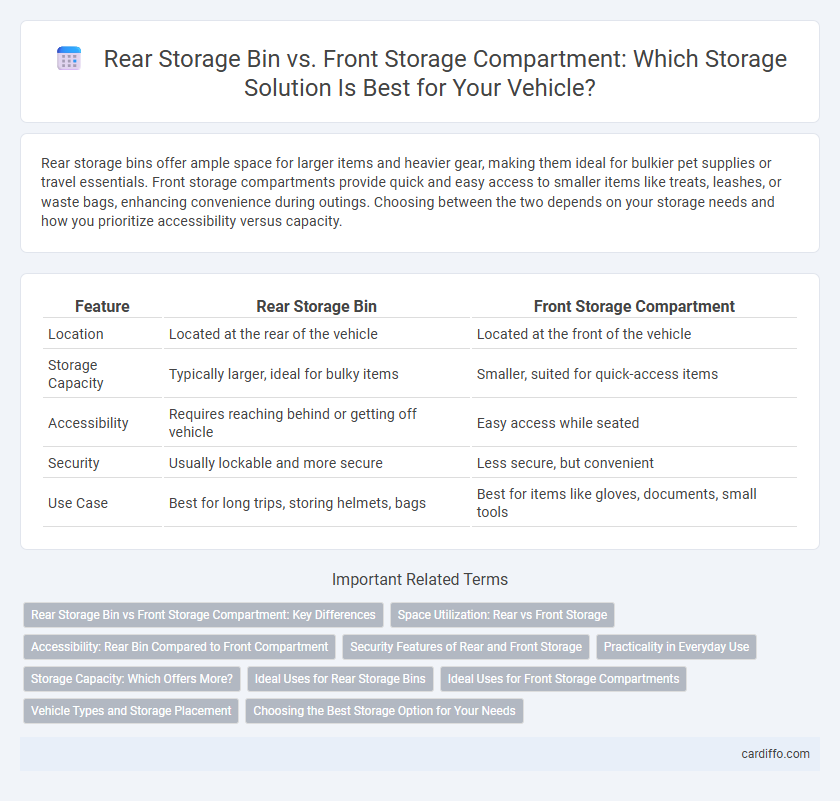Rear storage bins offer ample space for larger items and heavier gear, making them ideal for bulkier pet supplies or travel essentials. Front storage compartments provide quick and easy access to smaller items like treats, leashes, or waste bags, enhancing convenience during outings. Choosing between the two depends on your storage needs and how you prioritize accessibility versus capacity.
Table of Comparison
| Feature | Rear Storage Bin | Front Storage Compartment |
|---|---|---|
| Location | Located at the rear of the vehicle | Located at the front of the vehicle |
| Storage Capacity | Typically larger, ideal for bulky items | Smaller, suited for quick-access items |
| Accessibility | Requires reaching behind or getting off vehicle | Easy access while seated |
| Security | Usually lockable and more secure | Less secure, but convenient |
| Use Case | Best for long trips, storing helmets, bags | Best for items like gloves, documents, small tools |
Rear Storage Bin vs Front Storage Compartment: Key Differences
The rear storage bin typically offers larger capacity and easier access when loading bulky items, while the front storage compartment is designed for smaller, frequently accessed belongings. Rear storage bins often provide enhanced security and weather protection compared to front compartments, which prioritize convenience and quick reach. Choosing between the two depends on the storage needs, with rear bins better suited for heavy or voluminous items and front compartments ideal for everyday essentials.
Space Utilization: Rear vs Front Storage
Rear storage bins typically offer larger volume capacity and deeper dimensions ideal for bulky items, enhancing overall space utilization in vehicles or devices. Front storage compartments provide easier access and better organization for smaller essentials, optimizing convenience despite limited space. Efficient space utilization is achieved by balancing the expansive rear storage with the accessible front compartment to meet diverse storage needs.
Accessibility: Rear Bin Compared to Front Compartment
Rear storage bins offer enhanced accessibility due to their larger openings and lower placement, allowing users to easily load and unload bulky items without awkward bending or stretching. Front storage compartments, while more convenient for quick access to smaller items, often feature limited space and require reaching over the vehicle's frame or dashboard. Evaluating user needs for frequent access and item size determines the optimal choice between rear and front storage options.
Security Features of Rear and Front Storage
Rear storage bins often provide enhanced security features such as lockable lids and reinforced construction to prevent unauthorized access and protect valuable items. Front storage compartments typically include integrated locking mechanisms and may be positioned within the rider's line of sight, offering quick access while maintaining security. Both storage options utilize durable materials designed to resist tampering and environmental damage, ensuring the protection of stored belongings.
Practicality in Everyday Use
Rear storage bins offer increased capacity for larger items, making them ideal for groceries or bulky gear, while front storage compartments provide quick access to essentials like keys and wallets. The placement of rear bins enhances weight distribution and stability, whereas front compartments prioritize convenience and frequent use. Both storage types complement each other by balancing volume and accessibility to improve everyday practicality.
Storage Capacity: Which Offers More?
Rear storage bins typically offer greater storage capacity compared to front storage compartments, accommodating larger and bulkier items with ease. Front storage compartments are generally smaller, designed for quick access to essentials but limited in volume. For maximizing storage space, especially in vehicles or motorcycles, rear bins provide more efficient and ample capacity.
Ideal Uses for Rear Storage Bins
Rear storage bins offer ideal uses for securely housing bulky or heavy items such as tools, sports equipment, or groceries, keeping them easily accessible and balanced in vehicle weight distribution. Their larger capacity compared to front storage compartments makes them perfect for long trips or daily errands where ample space is essential. Rear bins also enhance convenience by minimizing clutter within the cabin, thereby improving safety and comfort during travel.
Ideal Uses for Front Storage Compartments
Front storage compartments are ideal for storing smaller, frequently accessed items such as sunglasses, mobile phones, and keys, offering easy reach and enhanced convenience. Their location near the driver or passenger ensures quick access to essentials without disrupting the driving experience. Compared to rear storage bins, front compartments are better suited for organizing personal belongings that require immediate availability.
Vehicle Types and Storage Placement
Rear storage bins are typically found in SUVs, trucks, and vans, offering spacious cargo areas ideal for larger items and bulkier gear. Front storage compartments, common in compact cars, sedans, and some electric vehicles, provide convenient access for smaller essentials and personal items near the driver and passenger seats. Storage placement in rear bins maximizes overall capacity, while front compartments enhance accessibility and organization within the cabin.
Choosing the Best Storage Option for Your Needs
Rear storage bins offer larger capacity and easier access when loading bulky items, making them ideal for transporting tools, groceries, or sports gear. Front storage compartments provide quicker access and convenience for smaller essentials like helmets, gloves, or documents, enhancing everyday usability. Evaluating your typical storage requirements and space preferences ensures you select the most functional and efficient option for your vehicle or equipment.
Rear Storage Bin vs Front Storage Compartment Infographic

 cardiffo.com
cardiffo.com